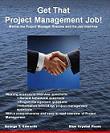Top -Banner
 |
Get That Project Management Job:
Master the
Project Manager Resume and the Job Interview
By George T. Edwards
2012 Edition
|
Part 2 - Project Management Theory
Extracts
6.7 Earned Value
Earned Value Analysis (EVA) in its various forms is a widely
accepted method of performance measurement. It is used to estimate how
a project is doing in terms of schedule and budget.
Earned value is a measure of the value of work performed so far. It uses original estimates and progress-to-date to show whether the actual costs incurred are on budget and whether the tasks are ahead of or behind the baseline plan.
It can answer the following questions in time and money:
Where are we now?
Where are we going?
Earned Value Analysis (EVA) involves calculating three key values for each activity:
1. Planned Value
2. Actual Cost
3. Earned Value
Planned Value (PV) is the portion of the approved cost estimate planned to be spent on an activity during a given period.
Actual Cost (AC) is the total cost incurred in accomplishing work on the activity during a given period.
Earned Value (EV) is the value of the work actually completed.
Examples:
Planned Value, week 1
Task 1: 10 hours at $200 per hour = $2,000
Task 2: 20 hours at $200 per hour = $4,000
Results at the end of week 1:
Task 1:
Hours worked: 12 => Actual Cost > (12 X $200) = $2,400
Status (percent complete): 100% (Completed):
Earned Value % complete X (Total Planned Value)
Earned Value = (100% X $2000)) = $2,000
Task 2:
Hours worked: 5 = > Actual Cost > (5 X $200) = $1,000
Status (percent complete): 50%:
Earned Value % complete X (Total Planned Value)
Earned Value = (50% of $4,000) = $2,000
Earned Value Performance Indicators
Cost Variance (CV) = EV - AC
A positive value is good, while a negative value indicates trouble
Cost Performance Index (CPI) = EV / AC
Cost is under control if 0.95 < CPI < 1.10 (Use as a guide, not as a hard rule.)
If the CPI is over 1, the project is progressing at a lower cost than planned.
Schedule Variance (SC) = EV - PV
A positive value is good, while a negative value indicates trouble
Schedule Performance Index (SPI) = EV / PV
Schedule is under control if 0.95 < SPI < 1.10 (Use as a guide, not as a hard rule.)
If the SPI is over 1 the project is progressing at a faster rate than planned.
Other calculations:
Estimate at Completion (EAC) is a forecast of most likely total project costs based on project performance and risk quantification.
It can be calculated in different ways:
EAC = Actual due dates + new estimate for all remaining work
Used when past performance shows that the original estimating assumptions were fundamentally flawed
EAC = Actual due dates + remaining budget
Used when current variances are seen as typical and the project
management team expectations are that similar variances will not occur
in the future
EAC = Actual due dates + remaining budget modified by a performance factor (CPI)
Used when current variances are seen as typical of future variances
Notes about terminology:
Planned value is also called Budgeted Cost of Work Scheduled (BCWS).
Actual cost is also called Actual Cost of Work Performed (ACWP).
Earned value is also called Budgeted Cost of Work Performed (BCWP).
Earned value must be calculated at the level of cost control and this might be higher than the level of task control.
Section 11 Project Risk Management
A risk is an uncertain event that, if it occurs, has a positive or negative effect on a project objective.
A risk trigger is an indication that a risk has occurred or is about to occur.
11.1 Risk Management
Risk management is the systematic process of identifying, analyzing and responding to project risk.
Risk management minimizes the probability of adverse events and their consequences for project objectives.
Risk management also looks to maximize the probability and consequences of positive events that may happen to the project.
- The risk management process must ensure that the level, type
and visibility of risk management are commensurate with both the risk
and importance of the project to the organization. (The same risk will
have a different impact on different projects.)
11.2 Risk Management Process
|
Risk Management Planning - Decide how to approach and plan the risk management for the project.
|
|
-
|
|
Risk Identification - Determine which risks might affect the project and document their characteristics.
|
|
-
|
|
Qualitative Risk Analysis - Subjective analysis for occurrence, impact and criticality.
|
|
-
|
|
Quantitative Risk Analysis - Numerical analysis for occurrence, impact and criticality.
|
|
-
|
|
Risk Response Planning - Actions to take about identified risks.
|
|
-
|
|
Risk
Monitoring and Control - Keep track of risks and plans, identify new
risks and ensure execution of risk management and response plans.
|
|
Risk identification requires an understanding of the project's
mission, scope and objectives of the owner and stakeholders. (Generic
checklists may not cover all risks.)
11.3 Risk Management Plan
The risk management plan is how risk identification, qualitative and
quantitative analysis, response planning, monitoring and control will
be structured and performed during the project life cycle. It may
include:
Tools to be used
Roles and Responsibilities: defines the lead, support, and risk
management membership for each type of action in the risk management
plan
Reporting Formats: describes how the results of the risk management
processes will be documented, analyzed and communicated to the project
team, stakeholder and sponsor
- Tracking: documents how all facets of risk activities will
be recorded for the benefit of the current project, future needs, and
lessons learned
11.4 Risk Identification Tools
Brainstorming
Delphi Technique - The same questions are asked individually to different experts, to get an unbiased opinion
Interviewing
Strengths, Weaknesses, Opportunities and Threats (SWOT) Analysis
External Risks
- Checklist created from similar projects
11.5 Qualitative Risk Analysis
Qualitative risk analysis is the process of assessing the impact and
likelihood of identified risks. It prioritizes risks according to their
potential effect on project objectives. The probability and
consequences of the risks are evaluated using established
qualitative-analysis methods and tools.
11.6 Quantitative Risk Analysis
Quantitative risk analysis looks to quantify the probability of each risk and its consequence on project objectives.
11.7 Risk Response Planning
Risk response planning is the process of developing options and
determining actions to enhance opportunities and reduce threats to the
project's objectives.
Mitigation:
Take steps to reduce the probability of the occurrence and the
impact of the risk if it happens. It may take the form of implementing
a new course of action that will reduce the problem (e.g. conducting
engineering tests).
Avoidance:
Eliminate the risk by changing the project plan.
It consists in changing the project plan to eliminate the risk or to protect the project objective from its impact.
Obtaining information
Improving communication
Reducing scope to avoid high-risk activities
Adding resources or time
Transference:
The risk is transferred to another entity. It will involve the
payment of a risk premium and does not actually eliminate it, but
transfers the ownership of it.
It consists of seeking to shift the consequence of a risk to a third party.
Transferring the risk gives another party the responsibility for its management. It doesn't eliminate it.
It is most effective in dealing with financial risk exposure.
It involves the payment of a risk premium to the party taking on the risk.
Acceptance:
If the response is acceptance, the team may develop a contingency
plan so if the risk actually happens, there is a way to mitigate its
impact. The impact could be so low (or so high) that no response is
planned ahead of the occurrence.
2.0 description

|
Includes: The role of the
project manager * How to write an outstanding resume
for project managers * Behavioural interview questions
* Project
management questions and answers * Information technology
project management
questions and answers * Microsoft Project questions and answers * Easy
to read guide to the
PMBOK
Now
available on e-book format (PC, Mac, Ipad).
E-book

|
|

